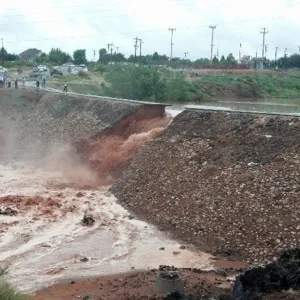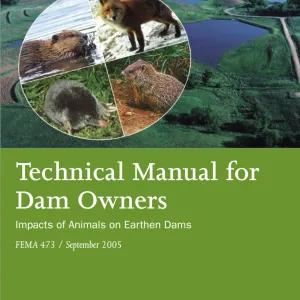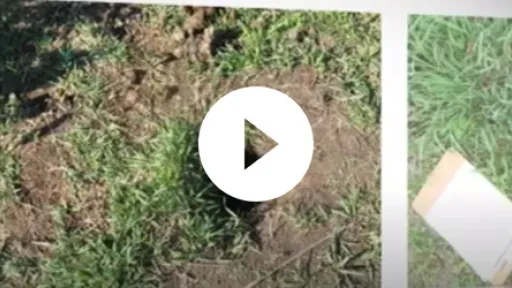Embankment dams and levees are vulnerable to damage from wildlife intrusions and animal impacts.
Earth embankment dams and levees are vulnerable to damage from wildlife intrusions and animal impacts. Dams are often located in areas that are desirable to wildlife: outside of developed areas near a water source with a variety of vegetation. Some animals excavate burrows, tunnels, and dens for shelter, while other predatory animals will enlarge these burrows by digging in search of prey. In addition, herbivorous animals forage on vegetation growing on embankment dams. These animal activities can create open areas on and within the fill that impact the safety and performance of the dam. Some of the effects, such as surface erosion, are easily identified. Other impacts like internal erosion may not be apparent or may only manifest themselves after a significant time. Wildlife species that commonly damage earth embankments include nutria, livestock, muskrat, beaver, moles and voles, geese, gopher, badger, armadillo, coyote, alligator, crayfish, and ants.
State dam safety officials and federal agencies agree that animal burrows within dams can cause substantial and costly damage if left unmitigated and are a major concern in the safe operation and maintenance of structures (FEMA, 2005). A study by Bayoumi and Meguid in 2011 found that the annual cost of rodent impacts on earthen structures is over one billion dollars (USD).

Animal activity around dams can impact how water moves through and under embankments; it can also undermine structural integrity and cause surface erosion. The presence of animal burrows anywhere on or around the dam can change the phreatic surface. Burrows on the upstream face of the dam can allow the reservoir to extend into the embankment and increase the elevation of the phreatic surface within the dam. Similarly, burrows on the downstream face can allow the phreatic surface to increase and daylight higher on the downstream slope. The changes in phreatic surface as a result of animal activity also cause changes in pore water pressures throughout the embankment. These changes to the phreatic surface and pore water pressures can shorten seepage paths, increase seepage volumes, decrease the factor of safety against slope failure, and lead to internal erosion of embankment materials. (FEMA, 2005).
When animals excavate dens, burrows, and tunnels within embankment dams, they create voids and open spaces that weaken the structural integrity of the dam. They can also allow the intrusion of surface water into the embankment. Rain and snow events loosen soils around a burrow, causing a burrow to collapse. Animal dens also erode and collapse under the load of heavy equipment and other vehicles using the dam crest as a road. The collapse of burrows often causes sinkholes to form. Dam owners and operators should make note of any new sinkholes or depressions and address them immediately.
As animals forage for food on and around embankments, they reduce vegetative cover which can lead to the formation of preferential flow paths, rills, and gullies along the dam faces. Livestock should be excluded from earthen embankments. If livestock trails and surface erosion are not addressed, they can contribute to failure modes during storm events.

There are several notable examples of dam failures and incidents related to animal impacts. In 2012, a flood control dam in the City of Santa Clara, Utah failed during a storm event. An investigation determined that the failure was caused by rodent burrows penetrating through or nearly through the dam. Observations noted in an inspection report a few months prior to the failure identified active rodent burrows on the upstream and downstream slopes of the dam. Eyewitness accounts described water flowing out of rodent holes on the downstream face of the embankment during the rise and release of the reservoir as well as rodents swimming away from the dam. Downstream flooding damaged 61 homes and 16 businesses and caused an estimated $7.5 million in damages to property and infrastructure.
In 1993, a waste pond owned near Richland, Washington failed. The failure of the 15-foot-high embankment released 300 acre-feet of wastewater downstream. State inspections in 1981 and 1985 found that the embankment was riddled with animal burrows and had recommended that the burrows be filled and the animals removed from the site. Repairs were not made and subsequently, in 1993, the embankment failed. The failure was attributed to high reservoir levels due to snowmelt that entered animal burrows near the embankment crest and eroded the dam. The breach washed out the Union Pacific Railroad tracks, derailing five locomotives and causing $5 million in damage (FEMA, 2005).
In 1971, the Sid White Dam near Omak, Washington failed. It was an earthen dam that failed due to seepage through animal burrows. The failure of this dam then caused a second dam to fail, dumping debris into the town of Riverside (Puyallup Tribe, 2017).
Regular inspection is a critical part of operating any dam and should consider wildlife activity. A typical inspection report should comment on vegetation, slope protection, erosion, instabilities, and animal burrows observed. In evaluating animal impacts, inspectors should look for burrow entrances, mounds of excavated soil, debris (e.g. indication of beaver activity), cracks, depressions, erosion, sinkholes, paths, ruts, sloughs, slides, and scarps. These conditions can indicate damaging animal activity. The inspection report should note whether the deficiencies warrant monitoring, repair, or further investigation. (FEMA, 2005).
In developing control and prevention measures, it is important to identify the species causing damage. Mitigation should be geared toward the species responsible for the damaging activity. It is possible that multiple species may be responsible for compromising activities at the dam. Control, prevention, and mitigation may need to be geared toward several species. State wildlife agencies should be consulted to ensure compliance with state regulations. (FEMA, 2005).
Mud-packing is a common method of backfilling a burrow in an embankment. This simple, inexpensive method can be accomplished by placing one or two lengths of metal stove or vent pipe in a vertical position over the entrance of the den. A mud-pack mixture is then poured into the pipe until the burrow and pipe are filled with the mixture. The pipe is removed, and dry earth is tamped into the entrance. The mud-pack is made by adding water to a 90 percent earth and 10 percent cement mixture until a slurry or thin cement consistency is attained. All entrances should be plugged with well-compacted earth and vegetation reestablished. Dens should be eliminated without delay because damage from just one hole can lead to failure of an embankment. (ASDSO, 2021).
Animals can pose significant threats to the performance and integrity of earthen embankments if their impacts are not addressed. Safe dam operation includes comprehensive and timely inspection and observation of animal impacts, accurate wildlife identification and mitigation, and appropriate repair and preventive measures.
References:
(7) Taccari, M.L. & Van Der meij, R. (2016). Investigation of the influence of animal burrowing on the failure of the levee of San Matteo along the Secchia river. E3S Web of Conferences, 9.
This lesson learned summary was peer-reviewed by Cory Miyamoto, P.E., CA Department of Water Resources; and Mike Hand, P.E., WYOH2OPE.



Santa Clara Dam (Utah, 2012)
Additional Case Studies (Not Yet Developed)
- Iowa Beef Processors Waste Pond Dam No.1 failure (Washington, 1993)
- Sid White Dam failure (Washington, 1971)
- Levee failure along the Secchia River (Italy, 2014)

Evaluation and Monitoring of Seepage and Internal Erosion

Technical Manual for Dam Owners: Impacts of Animals on Earthen Dams

Canal Operation & Maintenance: Animals

Dam Ownership Fact Sheet: Rodent Control

Dam Safety Fact Sheets: Information for Dam Owners

Guidelines for Landscape Planting and Vegetation Management at Levees, Floodwalls, Embankment Dams, and Appurtenant Structures

Pocket Safety Guide for Dams and Impoundments











